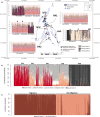Eco-evolutionary factors that influence its demographic oscillations in Prochilodus costatus (Actinopterygii: Characiformes) populations evidenced through a genetic spatial-temporal evaluation
- PMID: 37124086
- PMCID: PMC10130561
- DOI: 10.1111/eva.13544
Eco-evolutionary factors that influence its demographic oscillations in Prochilodus costatus (Actinopterygii: Characiformes) populations evidenced through a genetic spatial-temporal evaluation
Abstract
The human activity impact on wild animal populations is indicated by eco-evolutionary and demographic processes, along with their survival and capacity to evolve; consequently, such data can contribute toward enhancing genetic-based conservation programs. In this context, knowledge on the life-history and the eco-evolutionary processes is required to understand extant patterns of population structure in Prochilodus costatus a Neotropical migratory fish that has been threatened due to loss and fragmentation of its natural habitat since 1960s promoted by the expansion of hydroelectric power plant construction programs. This study evaluated the eco-evolutionary parameters that cause oscillations in the demography and structure of P. costatus populations. An integrated approach was used, including temporal and spatial sampling, next-generation sequencing of eight microsatellite loci, multivariate genetic analysis, and demographic life-history reconstruction. The results provided evidence of the complex interplay of ecological-evolutionary and human-interference events on the life history of this species in the upper basin. In particular, spawning wave behavior might have ecological triggers resulting in an overlapping of distinct genetic generations, and arising distinct migratory and nonmigratory genetic patterns living in the same area. An abrupt decrease in the effective population size of the P. costatus populations in the recent past (1960-80) was likely driven by environment fragmentation promoted by the construction of the Três Marias hydropower dam. The low allelic diversity that resulted from this event is still detected today; thus, active stocking programs are not effective at expanding the genetic diversity of this species in the river basin. Finally, this study highlights the importance of using mixed methods to understand spatial and temporal variation in genetic structure for effective mitigation and conservation programs for threatened species that are directly affected by human actions.
Keywords: Bayesian Skyline Plot; adegenet; evolution; historical demography; spawning waves.
© 2023 The Authors. Evolutionary Applications published by John Wiley & Sons Ltd.
Conflict of interest statement
None declared.
Figures


References
-
- Abreu, L. G. A. C. , & Maillard, P. (2016) Determinação de curva “cota x área” do reservatório da UHE Três Marias com o uso de radar altimétrico e imagens orbitais.
-
- Agostinho, A. A. , Gomes, L. C. , Veríssimo, S. , & Okada, E. K. (2004). Flood regime, dam regulation and fish in the Upper Parana River: Effects on assemblage attributes, reproduction and recruitment. Reviews in Fish Biology and Fisheries, 14(2004), 11–19.
-
- Agostinho, A. A. , Pelicice, F. M. , Gomes, L. C. , & Júlio, H. F. Jr (2010). Reservoir fish stocking: When one plus one may be less than two. Natureza & Conservação, 8(2), 103–111.
-
- Almada, F. , Francisco, S. M. , Lima, C. S. , FitzGerald, R. , Mirimin, L. , Villegas‐Ríos, D. , … Robalo, J. I. (2017). Historical gene flow constraints in a northeastern Atlantic fish: phylogeography of the ballan wrasse Labrus bergylta across its distribution range. Royal Society open science, 4(2), 160773. - PMC - PubMed
-
- Alves, C. B. M. , Vieira, F. , Magalhães, A. L. B. , & Brito, M. F. (2007). Impacts of non‐native fish species in Minas Gerais, Brazil: Present situation and prospects. In Bert T. M. (Ed.), Ecological and genetic implications of aquaculture activities (pp. 291–314). Dordrecht, Netherlands: Springer.
LinkOut - more resources
Full Text Sources
Miscellaneous

